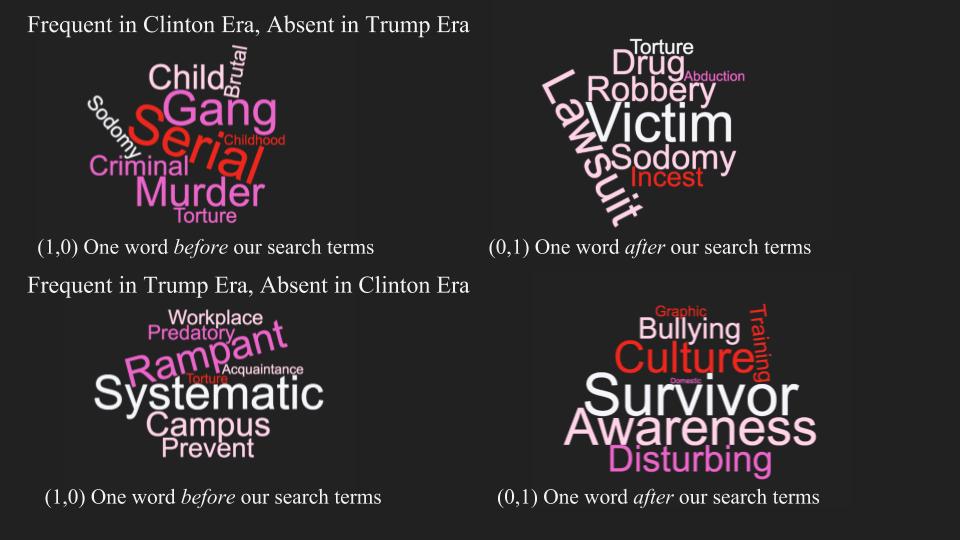Sexual Violence and Misconduct
Episodic and thematic coverage in two eras

As media coverage and overall visibility of survivors of sexual violence and misconduct has increased in recent months, how has it changed from previous years? And do these changes, if any, reveal a transition in coverage from being episodic to more thematic in nature?
Existing studies on this topic explain that episodic coverage tends to focus on specific and highly visible instances, while also giving more attention to perpetrators and specific institutions. In contrast, thematic coverage consists of portrayals that highlight survivors, and frames sexual assault and misconduct as a systemic issue that affects all sorts of people, in a wide variety of places.
To explore episodic and thematic coverage of sexual violence and misconduct, we based our research on the notion that there is an imbalance in the reporting of high profile cases. We framed our analyses around two such incidents: the Bill Clinton-Monica Lewinsky Scandal and the release of the Donald Trump Access Hollywood Tape. We assembled articles from two national newspapers that contained language related to our topic (such as sexual harassment, abuse, and rape) and that were published 14 months before and after each of these scandals. We ended up with nearly 20,000 articles, with around 8,000 published during the “Clinton Era” and 12,000 published during the “Trump Era.”
When looking at articles published in each time period, we examined words found near terms most relevant to our topic, such as “sexual harassment,” “sexual assault,” and “rape,” and created the word clouds shown above. The first set of visuals represents words that were likely to be found near our terms of interest in the Clinton Era, but were not as likely to be found near those terms in the Trump Era. The larger the word is, the more likely it is to be found near our search terms. These words, especially abduction, bestiality, and murder, are far more violent in nature, and are indicative of a more sensationalized, episodic approach to coverage of sexual violence and misconduct.
On the other hand, the subsequent word clouds contain words that were frequently found near our search terms (sexual harassment, assault, rape, etc.) in articles published during the Trump Era, but were rarely found in articles published during the Clinton Era. The relatively larger size of words like systematic, rampant, awareness, and culture suggests that coverage of sexual violence increasingly uses language that frames the topic as a more systemic issue.
In comparing the articles from the earlier time period with those published more recently, there do appear to be differences in the language used in coverage of the issue. And this apparent shift in language suggests that articles, in general, are moving from covering sexual violence and misconduct in an episodic to a more thematic manner. In addition to supporting the existing literature on episodic versus thematic coverage, our findings also shed light on the larger social context in which these changes are occuring: a world in which the media less often uses sensationalized coverage of sexual violence and misconduct to attract readers and increasingly emphasizes the story of victims.
-Mira Chugh
Note: This research was produced during January 2018, in collaboration with Jamison Fletcher, Erika Nakagawa, and lab member Will DiGravio.
Methodological note: We examined 19,790 articles that mentioned sexual assault, sexual misconduct, and related terms in the New York Times and Washington Post. Our analysis looked at articles published in two, separate, 28 month periods: November 17, 1996 to March 17, 1999 and August 7, 2015 to December 7, 2017. We used collocation analyses to generate lists of words that appeared most frequently near our key terms (like sexual assault, misconduct, rape, harassment). For more information on our methods, please click here.